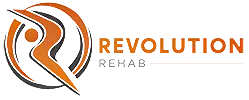That Nagging Forearm Pain? You’re Not Alone.
If you’ve ever overdone it at the gym, spent too many hours typing, or gone a little too hard on the tennis court, you’ve probably felt that unmistakable ache or tightness in your forearm. It’s more than just soreness—it could be a muscle strain. The good news? With the right physical therapy approach, you don’t have to live with it or wait forever to heal.
At Revolution Rehab, we help people just like you bounce back stronger, faster, and smarter after forearm muscle strains. Whether you’re an athlete, a busy professional, or just trying to get through your day pain-free, this guide will help you understand what’s going on—and how to fix it.
What Is a Forearm Muscle Strain, Exactly?
Your forearm is packed with muscles that control movement in your wrist, hand, and fingers. These muscles are divided into flexors (on the palm side) and extensors (on the back side). When one of these muscles gets overstretched or torn—either suddenly or over time—it’s considered a muscle strain.
The pain can be sharp or dull, and you might feel weakness, swelling, or tightness. And since we use our hands for, well, everything, even a mild strain can mess with your daily life.
Understanding how the forearm works is key to treating it right.
Why Forearm Strains Happen: Common Culprits
Forearm muscle strains don’t just happen to bodybuilders or racquet-sport athletes. There are lots of ways to end up in pain—and many of them might surprise you.
1. Overuse Injuries
Think repetitive movements: typing, lifting, painting, playing instruments, or sports like climbing, rowing, or tennis. When muscles don’t get time to rest, they break down.
2. Sudden Overload
Trying to lift something too heavy or bracing during a fall can stretch the muscle too far, causing microtears.
3. Poor Ergonomics
Working at a computer or on your phone with bad posture can strain the forearm muscles over time. Small, repeated motions in awkward positions add up.
4. Weak Core or Shoulder Stability
Believe it or not, when other parts of your body aren’t pulling their weight, your forearms often overcompensate—leading to unnecessary tension and strain.
5. Nerve-Related Conditions
Sometimes, what feels like a muscle strain is actually linked to nerve irritation or compression—like with carpal tunnel syndrome or radial tunnel syndrome. Physical therapy can help differentiate and treat these.
How to Know if It’s a Forearm Strain (and Not Something Else)
Some people try to power through forearm pain, hoping it’ll “just go away.” But ignoring it often makes it worse. Instead, it’s smart to understand what’s going on.
Self-Check Signs
- Pain or tenderness in the forearm, especially when gripping
- Swelling or bruising
- Difficulty carrying objects or doing push/pull tasks
- Weakness or fatigue in the hand/arm
- Pain that gets worse with activity but improves with rest
Red Flags That Require Help
- Numbness or tingling (especially in the fingers)
- Pain that doesn’t improve after a few days of rest
- Loss of grip strength
- Sharp or radiating pain
- Previous injury in the same area
When in doubt, book a consultation with a licensed physical therapist—especially if you use your hands and arms every day for work, hobbies, or sports. At Revolution Rehab, we’ll evaluate your range of motion, muscle strength, and movement patterns to figure out what’s really going on—and how to treat it effectively.
How Physical Therapy Helps Forearm Muscle Strain
Once we know what we’re dealing with, the goal is simple: reduce pain, restore function, and get you back to normal life—without the lingering tightness or fear of reinjury.
Here’s how we approach it at Revolution Rehab:
Phase 1: Reduce Pain & Inflammation
We start with hands-on techniques like:
- Soft tissue mobilization to reduce tightness
- Dry needling to release muscle knots (trigger points)
- Modalities like ice, heat, or electrical stimulation if needed
We’ll also guide you on how to rest properly without becoming stiff, and which activities to temporarily modify.
Phase 2: Restore Movement & Strength
This is where physical therapy shines. Once the acute pain settles, we introduce:
- Stretching for forearm flexors and extensors
- Isometric exercises to rebuild strength without aggravation
- Progressive resistance training using bands, light weights, or body weight
- Grip and wrist control training, especially if you work with your hands
Our therapists will tailor every exercise to your specific needs—no cookie-cutter programs here.
Phase 3: Prevent Reinjury
You don’t want this coming back. That’s why we address underlying causes—like poor posture, shoulder weakness, or bad lifting mechanics. We’ll show you how to move smarter in daily life.
And if your strain is related to a specific sport or job, we’ll build a return-to-activity plan that makes sense for your lifestyle.
Home Remedies (But Don’t Skip the PT)
There are a few things you can try at home, especially in the early stages:
- Rest the area, but don’t immobilize it completely—gentle movement is key.
- Apply ice for 15–20 minutes to reduce pain.
- Use compression sleeves to support the muscles.
- Try gentle stretching, but stop if it hurts.
- NSAIDs (like ibuprofen) may help reduce inflammation, but only short-term.
That said, home remedies often treat the symptoms—not the cause. If the pain lingers, it’s time to book with a professional who can guide your recovery.
Preventing Forearm Strains in the Future
No one wants to keep dealing with the same pain. A big part of what we do at Revolution Rehab is helping you stay pain-free long after you’ve left the clinic.
Here are a few tips we give our clients:
- Warm up before workouts or repetitive tasks
- Practice good ergonomics at your desk or workstation
- Take breaks every 30–60 minutes when using your hands a lot
- Keep your shoulders, core, and upper back strong
- Stretch regularly, especially after activity
- Pay attention to early warning signs—don’t wait for full-blown pain
These small changes can make a big difference—and we’ll teach you how to incorporate them into your daily routine without overthinking it.
Real Recovery Starts With Real Help
Forearm pain may feel small at first, but it can seriously get in the way of work, fitness, and everyday tasks. And if left untreated, it tends to stick around much longer than it should. The truth is, you don’t have to guess your way through recovery or wait for things to magically improve.
At Revolution Rehab, we make the healing process faster, smarter, and personalized to your life. From first-time injuries to recurring strains, our team of physical therapists knows exactly how to get your arm moving and feeling better—without unnecessary downtime.
Let’s get your hands—and your life—back in motion.
Book your consultation now and let’s start your recovery the right way.


